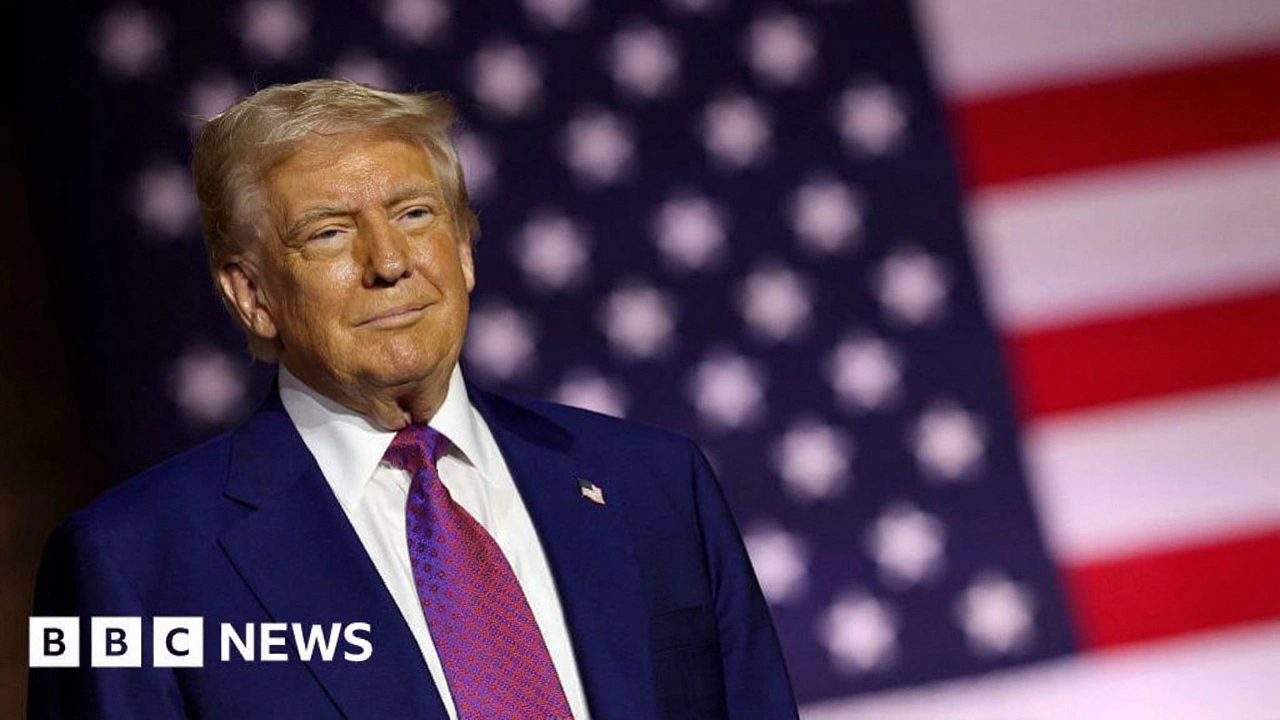
When Donald J. Trump unveiled his sweeping tariff plan on April 8, 2025, few anticipated how deeply it would ripple through American households — not just in prices, but in lifetime earnings. According to the Penn Wharton Budget Model, middle-income families could lose $22,000 over their lifetimes, as wages drop 5% and GDP shrinks by 6% in the long run. The shockwaves aren’t theoretical. By November 2025, the Committee for a Responsible Federal Budget was already warning that Trump’s promise to hand out $2,000 checks to every American — funded by tariff revenue — was a fiscal mirage. And here’s the thing: the tariffs haven’t even raised enough to cover one round of those payments.
The Tariff Math That Doesn’t Add Up
The Penn Wharton Budget Model released its analysis on April 10, 2025, and the numbers were brutal. Trump’s April 8 plan was projected to raise $5.2 trillion over a decade — on paper. But once you account for how businesses and consumers actually respond — reduced imports, lower investment, slower growth — the real haul drops to $4.5 trillion. Meanwhile, the U.S. capital stock, the foundation of productivity, was forecast to shrink by 0.6% by 2030 and nearly 10% by 2054. That’s not a minor dip. That’s a generational erosion of wealth.And it’s not just factories and investors who feel it. Workers are paying the price. By 2054, wages are projected to fall 3.9%, hours worked drop 1.3%, and overall output declines 5.1%. Even the federal debt, which some hoped tariffs would shrink, only falls 7.3% by 2030 and 11.6% by 2054 — a modest gain compared to the massive economic drag.
China Deal: A Temporary Breather, Not a Resolution
On November 10, 2025, the White House announced a breakthrough: a deal with China. Beijing agreed to suspend all retaliatory tariffs on U.S. agricultural exports — chicken, soybeans, pork, dairy, you name it — that had been in place since March 4, 2025. In return, the U.S. cut its tariffs on Chinese goods by 10 percentage points and froze further hikes until November 10, 2026.It sounds like progress. But here’s the twist: the deal didn’t reverse the core tariff structure. It merely paused escalation. And while China pledged to crack down on fentanyl chemicals — a political win for Trump — the underlying economic friction remains. The Peterson Institute for International Economics noted in its May 10, 2025, working paper that even the revised tariffs — after exemptions for Canada and Mexico under USMCA — still reduce global growth and stoke inflation. The deal didn’t fix the problem. It just bought time.
The $2,000 Dividend: A Fiscal Fantasy?
On Truth Social, Trump proposed sending every American $2,000 — paid for by tariff revenue. The Committee for a Responsible Federal Budget crunched the numbers: that’s $600 billion per round. But here’s the reality check: as of November 2025, the tariffs had collected only about $100 billion. Even the most optimistic projections — including those still under legal challenge — estimate annual collections of $300 billion. That’s half what’s needed for one dividend payout.The Cato Institute called it “pure fiscal fantasy” in a November 25 commentary. Even if you limit payments to tax filers earning under $100,000 — which Trump didn’t — the cost still ranges from $280 billion to $450 billion. And that’s not money pulled from thin air. It’s borrowed. And when you inject hundreds of billions into an economy already strained by supply shortages and inflation, you don’t get a boost — you get more inflation.
“Injecting tens or hundreds of billions of borrowed dollars into the economy would fuel demand without increasing supply,” the Cato analysis warned. “It’s a recipe for renewed price pressures.”

Capital Flight and the Fed’s Shadow
The Penn Wharton Budget Model also warned of a hidden consequence: as tariffs reduce imports, foreign investors buy fewer U.S. assets — stocks, bonds, real estate. That means less foreign capital flowing in. And when that happens, Americans are forced to fund their own government debt by buying more Treasuries, leaving less money to invest in productive businesses. It’s a vicious cycle.Meanwhile, J.P. Morgan Global Research reported in October 2025 that investor anxiety has shifted from trade wars to the Federal Reserve. Trump’s public criticism of Chairman Jerome Powell has already triggered drops in equities and Treasuries. The threat of removing Powell — even if unfulfilled — undermines confidence in the Fed’s independence, a cornerstone of global financial stability.
What’s Next? The Clock Is Ticking
Negotiations with Japan, South Korea, and India are ongoing, but they’re mixed. Some progress. Some posturing. Meanwhile, the November 10, 2026 deadline for the China tariff pause looms. If no new deal is struck, the U.S. could face renewed retaliation — and the agricultural sector, still reeling from earlier export losses, would be among the first hit.And what about the dividend? Trump hasn’t backed down. But Congress — even with GOP majorities — may balk at adding $600 billion to the deficit each year. The Committee for a Responsible Federal Budget projects that if the dividend is paid annually, U.S. debt will hit 134% of GDP by 2035 — up from 120% under current law. That’s not just unsustainable. It’s dangerous.

Why This Matters Beyond the Numbers
This isn’t just about tariffs or checks. It’s about a fundamental shift in economic philosophy: treating trade deficits as enemies to be punished, not imbalances to be managed. The data shows that punishing imports doesn’t bring back manufacturing jobs — it raises costs, lowers wages, and makes American goods less competitive globally. The farmers in Iowa, the factory workers in Ohio, the small business owners in Texas — they’re not benefiting from the tariff revenue. They’re paying for it in higher grocery bills and weaker paychecks.And the most ironic part? The very people Trump claims to protect — the middle class — are the ones losing the most.
Frequently Asked Questions
How much will Trump’s tariffs cost the average American household over time?
According to the Penn Wharton Budget Model, a middle-income household faces a lifetime loss of $22,000 due to lower wages and reduced economic growth from the April 2025 tariff plan. This comes from a 5% wage decline and 5.1% drop in output by 2054, even as federal debt falls slightly. The loss isn’t from direct taxes — it’s from slower income growth and higher prices over decades.
Why can’t Trump fund $2,000 dividend checks with tariff revenue?
Tariffs collected only about $100 billion through November 2025, while annual projections top $300 billion — still far short of the $600 billion needed for a full $2,000 payout to every American. Even if you limit payments to tax filers under $100,000, costs range from $280–450 billion. The gap forces borrowing, which fuels inflation and increases national debt, undermining the very economic stability the tariffs claim to protect.
Did the November 2025 deal with China fix the trade problem?
No. The deal paused retaliatory tariffs on U.S. farm goods and cut Chinese import tariffs by 10 percentage points — but only until November 2026. The core tariff structure remains, and China’s commitments on fentanyl chemicals are separate from trade policy. Economists warn this is a temporary truce, not a resolution. Without structural reforms, the next round of tensions is inevitable.
How are U.S. farmers and manufacturers being affected?
U.S. agricultural exports — soybeans, pork, wheat, dairy — faced sharp drops during China’s retaliatory tariffs in early 2025. While the November deal restored access, farmers remain vulnerable. Manufacturers face higher input costs from imported components, and many have shifted production overseas to avoid tariffs. The Peterson Institute found that durable goods industries suffered the most from reduced global supply chains.
What role is the Federal Reserve playing in this crisis?
President Trump’s public attacks on Fed Chair Jerome Powell have spooked markets, triggering declines in stocks and Treasury bonds. Investors fear political interference in monetary policy, which could lead to erratic interest rate decisions. The J.P. Morgan analysis notes this uncertainty is now a bigger market risk than the tariffs themselves — because it undermines confidence in the institution that controls inflation.
What happens if the dividend is paid and tariffs don’t bring in enough money?
If the $2,000 payments are made annually without sufficient tariff revenue, the U.S. would need to borrow the difference — adding roughly $600 billion per year to the deficit. The Committee for a Responsible Federal Budget projects this would push national debt to 134% of GDP by 2035, far above the 120% under current law. That level of debt typically leads to higher interest rates, reduced investment, and slower growth — exactly what the tariffs were supposed to prevent.
More Articles

Rashid Khan’s 200th ODI Wicket Powers Afghanistan Past Bangladesh in Abu Dhabi
Rashid Khan claimed his 200th ODI wicket as Afghanistan edged Bangladesh in a rain‑shortened match at Abu Dhabi, leveling the series after a 3‑0 T20I loss for the Afghans.

Is Formula One really a sport?
Formula One is a motorsport that is widely accepted as a sport. However, some people argue that it is not a sport because it does not involve physical activity. The article looks at the different arguments for and against Formula One as a sport. Some argue that it is a sport because it requires physical and mental skills, as well as the ability to make split-second decisions. Others argue that it is not a sport because the drivers are not active enough and the cars are doing most of the work. Ultimately, it seems that Formula One can be considered a sport, but the definition of a sport is a subjective matter.

The Profound Influence of The Shangri-Las on Amy Winehouse's Timeless Sound
Amy Winehouse, known for her retro style and deep musical roots, found major inspiration from 1960s girl groups like The Shangri-Las. This influence, rooted in her family's musical history, shaped her unique sound and defined hits from her acclaimed album 'Back to Black'.
